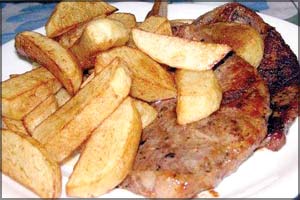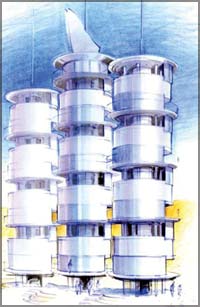|

Hunger triggered off by fatty foods:
Not empty stomach
New research led by the University of Cincinnati (UC) suggests that
the hunger hormone ghrelin is activated by fats from the foods we eat
"not those made in the body" in order to optimise nutrient metabolism
and promote the storage of body fat.
The findings, the study's author says, turn the current model about
ghrelin on its head and point to a novel stomach enzyme (GOAT)
responsible for the ghrelin activation process that could be targeted in
future treatments for metabolic diseases.
The laboratory study, led by Matthias Tschop MD, UC associate
professor of psychiatry and internal medicine, was published in the
journal Nature Medicine.
Ghrelin is a hormone that was believed to accumulate during periods
of fasting and is found in the body in high concentrations just before
meals. It is dubbed the "hunger hormone" because it has been shown that
administration of pharmacological (scientifically studied or researched)
doses acts in the brain to stimulate (to activate) hunger and increase
food intake in animal models and humans.The ghrelin hormone is unique in
that it requires acylation (the addition of a fatty acid) by a specific enzyme (ghrelin O-acyl transferase, or GOAT) for activation.
Originally it was assumed that the fatty acids attached to ghrelin by
GOAT were produced by the body during fasting. The new data by Tschop
and his team suggests that the fatty acids needed for ghrelin activation
actually come directly from ingested dietary fats. In a departure from
an earlier model that was upheld for nearly a decade, Tschop says, it
appears that the ghrelin system is a lipid sensor in the stomach that
informs the brain when calories are available, "giving the green light
to other calorie-consuming processes such as growing.
specific enzyme (ghrelin O-acyl transferase, or GOAT) for activation.
Originally it was assumed that the fatty acids attached to ghrelin by
GOAT were produced by the body during fasting. The new data by Tschop
and his team suggests that the fatty acids needed for ghrelin activation
actually come directly from ingested dietary fats. In a departure from
an earlier model that was upheld for nearly a decade, Tschop says, it
appears that the ghrelin system is a lipid sensor in the stomach that
informs the brain when calories are available, "giving the green light
to other calorie-consuming processes such as growing.
Tschop and his team used mouse models to test the effects of over
expressing the GOAT enzyme, or "knocking it out." They found that, when
exposed to a lipid-rich diet, mice without GOAT accumulated less fat
than normal mice, while those with over-expressed GOAT accumulated more
fat mass than normal mice.
"When exposed to certain fatty foods, mice with more GOAT gain more
fat," says Tschop. "Mice without GOAT gain less fat since their brain
does not receive the 'fats are here, store them' signal."
Tschop says that although his study can't be immediately extrapolated
(considered as valid) to humans, recent human studies at the University
of Virginia measured (separately) active and inactive ghrelin
concentrations.
Those studies showed that during fasting, active ghrelin levels were
flat, but during the presence of fat from foods, ghrelin levels peaked
with meals as previously described. Tschop says these human studies
support the new model for ghrelin.
"Our GOAT studies in mice offer an explanation of what could have
been happening during the longer fasting periods in these human
studies," Tschop adds. "Without dietary fats, ghrelin peaks remain
inactive and don't affect storage of fat.
Courtesy: Health and Medicine
Drinking water from air humidity
Not a plant to be seen, the desert ground is too dry. But the air
contains water, and research scientists have found a way of obtaining
drinking water from air humidity. The system is based completely on
renewable energy and is therefore autonomous (able to function on its
own).
|

Image courtesy
of Fraunhofer-Gesellschaft |
Cracks permeate (spread throughout) the dried-out desert ground, the
landscape bears testimony to the lack of water. But even here, where
there are no lakes, rivers or ground water, considerable quantities of
water are stored in the air. In the Negev desert in Israel, for example,
annual average relative air humidity is 64 per cent" in every cubic
metre of air there are 11.5 millilitres of water.
Research scientists at the Fraunhofer Institute for Interfacial
Engineering and Biotechnology IGB in Stuttgart working in conjunction
(jointly) with their colleagues from the company Logos Innovation have
found a way of converting this air humidity autonomously and decentraly
into drinkable water. "The process we have developed is based
exclusively on renewable energy sources such as thermal solar collectors
and photovoltaic cells, which makes this method completely
energy-autonomous. It will therefore function in regions where there is
no electrical infrastructure," says Siegfried Egner, head of department
at the IGB. The principle of the process is as follows: hygroscopic
brine 'saline solution which absorbs moisture' runs down a tower-shaped
unit and absorbs water from the air. It is then sucked into a tank a few
meters off the ground in which a vacuum (space completely empty of all
substances) prevails. Energy from solar collectors heats up the brine,
which is diluted by the water it has absorbed. Because of the vacuum,
the boiling point of the liquid is lower than it would be under normal
atmospheric pressure. This effect is known from the mountains: as the
atmospheric pressure there is lower than in the valley, water boils at
temperatures distinctly below 100 degrees Celsius. The evaporated,
non-saline water is condensed and runs down through a completely filled
tube in a controlled manner. The gravity of this water column
continuously produces the vacuum and so a vacuum pump is not needed. The
reconcentrated brine runs down the tower surface again to absorb
moisture from the air.
"The concept is suitable for various sizes of installation.
Courtesy: Science Daily
Name: Rochana Vipuli Jayasinghe
Gender: Female
Age: 12
Hobbies: Reading books, surfing the internet, watching movies
School: Girls' High School, Kandy
Pen-pals preferred from: UK, France, Russia, USA, India,
Japan, China, Austria, Germany.
Age group: 11-13 Girls only
Address: 309/41, Rajasinghe 1st Lane, George E. de Silva MW.,
Kandy
Email address: [email protected]
*****
Name: Gayathri Chamarika Mahaarachchi
Gender: Female
Age: 17
Hobbies: Watching TV, listening to music, reading books.
Pen-pals preferred from: England, India, Japan, Australia,
China, USA,Germany
Age group: 16-19
Address: Iresha Motor Tec, Mahagonaduwa,
Moronthuduwa, Sri Lanka
*****
Name: Madushka Janaki Weheregoda
Gender: Female
School: Maliyadeva Balika Vidyalaya, Kurunegala.
Hobbies: Reading books, watching cricket matches, listening to
music, collecting stamps
Pen-pals preferred from: Itlay and Germany (boys)
Age group: 14-15-16
Address: Daya's Stores, Nabeta, Melsiripura, Kurunegala, Sri
Lanka.
*****
Name: M. Tharushi Udara
Gender: Female
Age: 13
Hobbies: Collecting stamps, reading story books.
Pen-pal preferred from: Japan, England, Australia, France
Address: No. 98/D/6, Samagimawatha,
Banglawaththa, Pugoda, Sri Lanka. |

